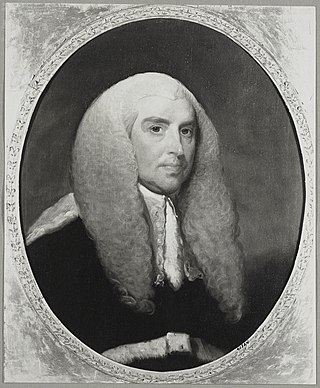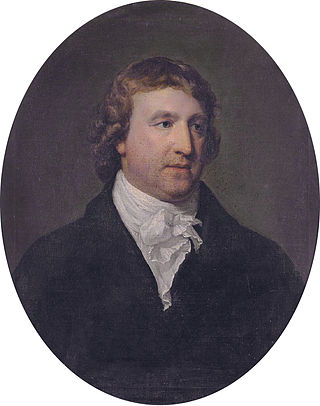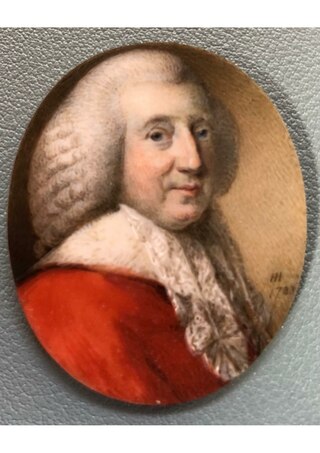
Hugh Edward Kennedy was an Irish judge, politician and barrister who served as Chief Justice of Ireland from 1924 to 1936, a judge of the Supreme Court from 1924 to 1936 and Attorney General of Ireland from 1922 to 1924. He served as a Teachta Dála (TD) for the Dublin South constituency from 1923 to 1924. As a member of the Irish Free State Constitution Commission, he was also one of the constitutional architects of the Irish Free State.
Earl of Clonmell, in the County of Tipperary, was a title in the Peerage of Ireland. It was created in 1793 for John Scott, 1st Viscount Clonmell, Lord Chief Justice of the King's Bench for Ireland. He had already been created Baron Earlsfort, of Lisson-Earl in the County of Tipperary, in 1784, and Viscount Clonmell in 1789. These titles were also in the Peerage of Ireland. He was succeeded by his son, the second Earl. He sat as Member of Parliament for New Romney. His grandson, the fourth Earl, was elected an Irish representative peer in 1874. The latter never married and was succeeded by his younger brother, the fifth Earl. He was a lieutenant-colonel in the Rifle Brigade and fought in the Ashanti War. He was childless and was succeeded by his first cousin, the sixth Earl. He was the eldest son of Colonel the Hon. Charles Grantham Scott, second son of the second Earl. On his death the titles passed to his son, the seventh Earl. Although married to music hall performer Rachel Estelle "Stella" Berridge, he died without male issue and was succeeded by his seventy-five-year-old uncle, the eighth Earl. The latter was childless and on his death in 1935 the titles became extinct. Family homes included Bishopscourt in County Kildare, Ireland (1838–1914) and Eathorpe Hall in Warwickshire, England.

Charles Manners, 4th Duke of Rutland was a British politician and nobleman, the eldest legitimate son of John Manners, Marquess of Granby. He was styled Lord Roos from 1760 until 1770, and Marquess of Granby from 1770 until 1779.
John Butler, 17th Earl of Ormonde, 10th Earl of Ossory (1740–1795) was an Irish peer and Member of Parliament (MP). He became a Protestant in 1764. He was an Irish MP, representing Gowran between 1776 and 1783, and Kilkenny City between 1783 and 1792. In 1791, his right to the peerage was acknowledged in the Irish House of Lords and he became the 17th Earl of Ormond.

Hugh Carleton MRIA, 1st Viscount Carleton, PC (I), SL was an Irish politician and judge.

Charles Hare Hemphill, 1st Baron Hemphill, PC QC, was an Irish politician and barrister.
Sir Samuel Bradstreet, 3rd Baronet was an Irish politician, barrister and judge. His independence of mind as a politician gave rise to the somewhat misleading nickname "Slippery Sam".

John Toler, 1st Earl of Norbury PC, KC, known as The Lord Norbury between 1800 and 1827, was an Irish lawyer, politician and judge. A greatly controversial figure in his time, he was nicknamed the "Hanging Judge" and was considered to be one of the most corrupt legal figures in Irish history. He was Chief Justice of the Irish Common Pleas between 1800 and 1827.

The Iveagh Gardens is a public park located between Clonmel Street and Upper Hatch Street, near the National Concert Hall in Dublin, Ireland. It is a national, as opposed to a municipal park, and designated as a National Historic Property. The gardens are almost completely surrounded by buildings making them less noticeable and a little hard to find, unlike other green spaces in Dublin.

Arthur Wolfe, 1st Viscount Kilwarden was an Anglo-Irish peer, politician and judge, who held office as Lord Chief Justice of Ireland. He was killed during the Irish rebellion of 1803.

Philip Tisdall SL was an Irish lawyer and politician, who held the office of Attorney-General for Ireland. He was for many years a leading figure in the Irish Government.
Thomas Scott, 2nd Earl of Clonmell, styled Lord Earlsfort between 1793 and 1798, was an Irish peer and politician.

William Downes, 1st Baron Downes PC was one of the leading Irish judges of his time, who held office as Lord Chief Justice of Ireland.

William Henn was an Irish judge, who is remembered now mainly for the somewhat malicious description of him in Sir Jonah Barrington's Personal Sketches.
Sir Vere Hunt, 1st Baronet of Currah was an Irish politician, landowner and businessman. He is chiefly remembered for founding the village of New Birmingham in County Tipperary, for his ill-advised purchase of the island of Lundy, and for his entertaining diary. He was a colourful character, who was noted for his heavy drinking and gambling, but also for his intellectual interests, and his stern criticism of his own class.
Sir John Everard was an Irish barrister, politician and judge. He was notable as the last Irish judge until the reign of James II to openly profess the Roman Catholic faith. His religious beliefs eventually led to his enforced resignation from the Bench in 1607.
The recorder of Cork was a judicial office holder in pre-Independence Ireland. The recorder was the chief magistrate of Cork city: his principal duty was to keep the peace. The office was very similar to that of the recorder of Dublin, except that the recorder of Cork, unlike his Dublin counterpart, did not have the power to preside over any trial involving a capital crime. A statute of 1877 stated that wherever possible the recorder should also be the Chairman of the Cork East Riding Quarter Sessions. The office of the recorder of Cork, like the recorder of Dublin, was an onerous one, involving at least two sittings of the Court every week; as a rule, the recorder had a deputy recorder to assist him. William Waggett, appointed in 1808, delegated all his duties to his Deputy Mr. Wilmot until the latter died in 1815.
John Bennett was an Irish politician, barrister and judge. His granddaughter married the celebrated writer Sheridan le Fanu.
Francis Mathew, 1st Earl Landaff was an Anglo-Irish politician and peer.

John Magee was an Irish journalist and lottery broker.












